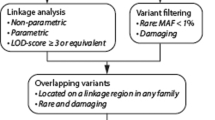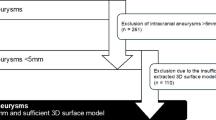Abstract
Intracranial aneurysms (IA) are the major cause of subarachnoid haemorrhages (SAH). A positive family history for SAH is reported in 5–10% of the patients. The mode of inheritance is not unambiguously established; both autosomal dominant and recessive modes have been reported. In sporadic as well as in familial SAH, approximately 60% of the SAH patients are female. Recently, anticipation has been described in familial SAH. Since up to 15% of the SAHs are not caused by an IA, we have analysed anticipation, sex ratio and mode of inheritance only in families with patients with a proven IA in two consecutive generations. A total of 10 families were studied in which at least two persons in consecutive generations were affected by SAH, a symptomatic IA (SIA) or a presymptomatic IA (PIA). We also analysed published data from families with a proven IA in two consecutive generations on age of SIA onset and sex ratios among affected family members (both SIA and PIA). The age of SIA onset in the parental generation (mean 55.5 years) differed significantly from the age of onset in their children (mean 32.4 years). In the parental generation 11 men and 37 women were affected (both SIA and PIA), in the consecutive generation these numbers were 28 men and 32 women. There is a significant difference in sex ratio of affected family members when the generations are compared (P<0.02). No family could be found in which three consecutive generations were affected by an IA (SIA or PIA).
Similar content being viewed by others
Log in or create a free account to read this content
Gain free access to this article, as well as selected content from this journal and more on nature.com
or
References
Hop JW, Rinkel GJE, Algra A, van Gijn J : Case-fatality rates and functional outcome after subarachnoid hemorrhage: a systematic review. Stroke 1997; 28: 660–664.
Linn FH, Rinkel GJE, Algra A, van Gijn J : Incidence of subarachnoid hemorrhage: role of region, year, and rate of computed tomography: a meta–analysis. Stroke 1996; 27: 625–629.
Bromberg JEC, Rinkel GJE, Algra A et al: Familial subarachnoid hemorrhage: distinctive features and patterns of inheritance. Ann Neurol 1995; 38: 929–934.
Lozano AM, Leblanc R : Familial intracranial aneurysms. J Neurosurg 1987; 66: 522–528.
Locksley HB : Natural history of subarachnoid hemorrhage, intracranial aneurysms and arteriovenous malformations. J Neurosurg 1966; 25: 321–368.
Warlow CP, Dennis MS, Gijn van J et al: What caused this subarachnoid haemorrhage?; in Anonymous Stroke: A Practical Guide to Management. Oxford: Blackwell Science Ltd, 1996, pp 322–359.
Schievink WI, Schaid DJ, Rogers HM, Piepgras DG, Michels VV : On the inheritance of intracranial aneurysms. Stroke 1994; 25: 2028–2037.
Chambers WR, Harper BFj, Simpson JR : Familial incidence of congenital aneurysms of cerebral arteries. JAMA 1954; 135: 358–359.
Bromberg JEC, Rinkel GJE, Algra A et al: Hypertension, stroke, and coronary heart disease in relatives of patients with subarachnoid hemorrhage. Stroke 1996; 27: 7–9.
Schievink WI, Limburg M, Dreissen JJR, Peeters FLM, ter Berg HWM : Screening for unruptured familial:intracranial aneurysms: subarachnoid hemorrhage 2 years after angiography negative for aneurysms. Neurosurgery 1991; 29: 434–437, discussion 437–438.
Endtz LJ : Familial incidence of intracranial aneurysms. Acta Neurochir 1968; 19: 297–305.
ter Berg HWM, Bijlsma JB, Veiga Pires JA et al: Familial association of intracranial aneurysms and multiple congenital anomalies. Arch Neurol 1986; 43: 30–33.
Schievink WI : Genetics of intracranial aneurysms. Neurosurgery 1997; 40: 651–662, discussion 662–663.
Ronkainen A, Hernesniemi J, Ryynanen M : Familial subarachnoid hemorrhage in east Finland, 1977–1990. Neurosurgery 1993; 33: 787–796, discussion 796–799.
Nakajima H, Kishi H, Yasui T et al: Intracranial aneurysms in identical twins. Surg Neurol 1998; 49: 306–308.
Ronkainen A, Miettinen H, Karkola K et al: Risk of harboring an unruptured intracranial aneurysm. Stroke 1998; 29: 359–362.
Rinkel GJE, Djibuti M, van Gijn J : Prevalence and risk of rupture of intracranial aneurysms: a systematic review. Stroke 1998; 29: 251–256.
Kojima M, Nagasawa S, Lee YE et al: Asymptomatic familial cerebral aneurysms. Neurosurgery 1998; 43: 776–781.
Fox JL, Ko JP : Familial intracranial aneurysms. Six cases among 13 siblings. J Neurosurg 1980; 52: 501–503.
Fox JL : Familial intracranial aneurysms. Case report. J Neurosurg 1982; 57: 416–417.
Patrick D, Appleby A : Familial intracranial aneurysm and infundibular widening. Neuroradiology 1983; 25: 329–334.
Raaymakers TW, Rinkel GJE, Ramos LM : Initial and follow–up screening for aneurysms in families with familial subarachnoid hemorrhage. Neurology 1998; 51: 1125.
Locksley HB, Sahs AL, Knowler L : Report on the cooperative study of intracranial aneurysms and subarachnoid hemorrhage. Section II. General survey of cases in the central registry and characteristics of the sample population. J Neurosurg 1966; 24: 922–932.
Bentzen N : Family incidence of intracranial aneurysms: case reports. NZ Med J 1972; 75: 153–155.
Verdura J, Resnikoff S, Rosenthal J, Cardenas J : Familial intracranial aneurysms, with two occurring at the distal anterior cerebral artery. Neurosurgery 1983; 12: 214–216.
ter Berg HWM, Dippel DWJ, Limburg M, Schievink WI, van Gijn J : Familial intracranial aneurysms. A review. Stroke 1992; 23: 1024–1030.
Edelsohn L, Caplan L, Rosenbaum AE : Familial aneurysms and infundibular widening. Neurology 1972; 22: 1056–1060.
Shinton R, Palsingh J, Williams B : Cerebral haemorrhage and berry aneurysm: evidence from a family for a pattern of autosomal dominant inheritance. J Neurol Neurosurg Psychiatry 1991; 54: 838–840.
Acosta-Rua GJ : Familial incidence of ruptured intracranial aneurysms. Report of 12 cases. Arch Neurol 1978; 35: 675–677.
Evans TW, Venning MC, Strang FA, Donnai D : Dominant inheritance of intracranial berry aneurysm. Br Med J Clin Res Ed 1981; 283: 824–825.
Brodsky MC, Frenkel RE, Spoor TC : Familial intracranial aneurysm presenting as a subtle stable third nerve palsy. Case report. Arch Ophthalmol 1988; 106: 173.
Elshunnar KS, Whittle IR : Familial intracranial aneurysms: report of five families. Br J Neurosurg 1990; 4: 181–186.
Chakravorty B, Gleadhill CA : Familial incidence of cerebral aneurysms. Br Med J 1966; 5480: 147–148.
Nagae K, Goto I, Ueda K, Morotomi Y : Familial occurrence of multiple intracranial aneurysms. Case report. J Neurosurg 1972; 37: 364–367.
Morooka Y, Waga S : Familial intracranial aneurysms: report of four families. Surg Neurol 1983; 19: 260–262.
Maroun FB, Murray GP, Jacob JC, Mangan MA, Faridi M : Familial intracranial aneurysms: report of three families. Surg Neurol 1986; 25: 85–88.
Jaksche H : Familiäre Aneurysmen. Vier Karotisaneurysmen aus einer zehnköpfigen Familie. Zentralbl Neurochir 1986; 47: 351–353.
Ambrosetto P, Galassi E : Familial occurrence of multiple intracranial aneurysms. Case reports and review of the literature. Acta Neurochir 1981; 56: 233–238.
Jain KK : Familial intracranial aneurysms. Review of literature and presentation of six new cases. Acta Neurochir 1974; 30: 129–137.
Leblanc R, Melanson D, Tampieri D, Guttmann RD : Familial cerebral aneurysms: a study of 13 families. Neurosurgery 1995; 37: 633–638, discussion 638–639.
Brisman R, Abbassioun K : Familial intracranial aneurysms. J Neurosurg 1971; 34: 678–682.
Acknowledgements
We thank the investigators from the MARS study, UW Huisman, R Groen, and PJAM Brouwer, for referring families. This research is supported by a grant of the Netherlands Heart Foundation. (Grant no.: 96.103).
Author information
Authors and Affiliations
Corresponding author
Rights and permissions
About this article
Cite this article
Struycken, P., Pals, G., Limburg, M. et al. Anticipation in familial intracranial aneurysms in consecutive generations. Eur J Hum Genet 11, 737–743 (2003). https://doi.org/10.1038/sj.ejhg.5201039
Received:
Revised:
Accepted:
Published:
Issue date:
DOI: https://doi.org/10.1038/sj.ejhg.5201039



